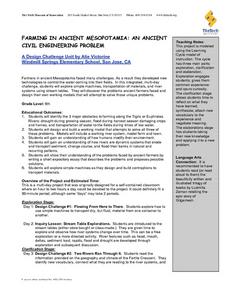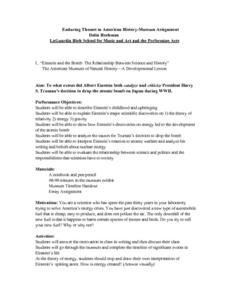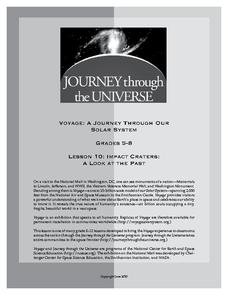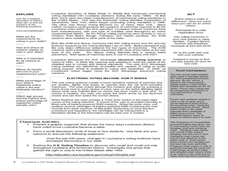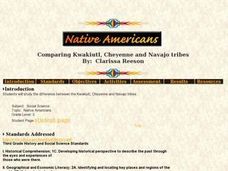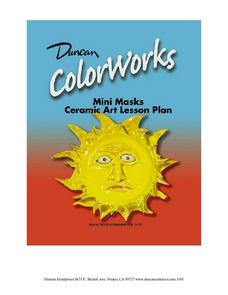J. Paul Getty Trust
Still-Life Painting: Arranging Nature—Lesson 1
Art learners examine still-life arrangement images and respond to a series of prompts. In a whole-class discussion, pupils list elements and qualities that still-life paintings can have. After instructors create an arrangement and model...
Curated OER
Products Made from Petroleum
High schoolers research products made from petroleum. In this transportation activity students try to find products other than fuel, made from petroleum. They look for the most unusual or surprising products and describe the history and...
Curated OER
The Humanitarian Side of Architecture
Students explore the role that architects play in rebuilding communities after natural disasters. They investigate the aftermath of the 1906 California earthquake and fires, and current day efforts to rebuild communities after natural...
Curated OER
Museum Adventure WebQuest
Students discover the background and properties of minerals. They examine fluorite and record data after testing it. They use the internet to help them discover information about minerals.
American Museum of Natural History
Journey to Deep Sea Vents
Take a deep dive into oceanography. The online interactive allows for learners to board a submersible to dive to the bottom of the ocean to investigate sea vents. On the way down, individuals see different marine life at different...
Curated OER
Role of Masks in African Cultures
Students explore ancient tradition and craft of mask making, examine role or function of masks in African culture, create instruments, and participate in class projects.
Curated OER
A Bug's Journey
Students research the art of John Baldessari. In this art history lesson, students examine Baldessari's drawing of a beetle and discuss the characteristics of these bugs. They write a story from a bug's perspective and create their own...
Curated OER
Farming in Ancient Mesopotamia: An Ancient Civil Engineering Problem
Sixth graders identify the major obstacles in farming in Mesopotamia. They work together to design and build a model that solves these problems. They write a short essay that describes the problems and their possible solutions.
Curated OER
Enduring Themes in American History-Museum Assignment
Students study and research the life of Albert Einstein. They focus on the extent Albert Einstein catalyzed and criticized President Harry S. Truman's decision to drop the atomic bomb on Japan during WWII. Students answer a series of...
Curated OER
What's In A Name?
Young scholars create a binomial system of nomenclature for classifying organisms they encounter in a field trip to a natural history museum or from pictures in library books. They work in small groups to create accurate drawings and...
Journey Through the Universe
Impact Craters: A Look at the Past
The Galle crater on Mars is also known as the Happy Face crater because of its appearance. First, scholars use pebbles and flour to simulate craters and study their properties. They then apply this knowledge to help decipher the history...
Theodore Roosevelt Association
Roosevelt's Legacy: Conservation
The legacy of Theodore Roosevelt carries through modern American politics, economics, foreign policy, and society. But his proudest and most profound efforts were in the world of conservation, and in preserving the natural beauty of...
American Museum of Natural History
Draw a Monarch Butterfly: Scientific Illustrations
One doesn't have to be an artist to appreciate nature. A thorough resource shows pupils how to create detailed illustrations of a monarch butterfly. The lesson highlights the benefits of creating scientific drawings as opposed to simply...
Indian Land Tenure Foundation
A Sense of Belonging
In order to understand how the land changes over time because of the people who live there, learners interview an elderly person about the past. Children ask an older family member to describe what the local area was like when they were...
Curated OER
How We Vote
Students fill in a graphic organizer and discuss the struggles in groups about the history of voting in Louisiana. Students also explore a voting timeline to see who could and could not vote before and after 1850.
Curated OER
Out and About: Railways
Young scholars explore British Railway history. In this railway lesson, students may visit the Natural Railway Museum, the Darlington Railway Centre and Museum, or Steam - Museum of the Great Western Railway online or in-person to...
Curated OER
"The Science Times"
Students create their own newspaper after gathering information at the Museum of Natural History's Hall of Biodiversity.
Curated OER
Comparing Kwakiutl, Cheyenne and Navajo tribes
Third graders study the difference between the Kwakiutl, Cheyenne and Navajo tribes. They identify the people, resources, lifestyle and beliefs of the Kwakiutl, Cheyenne, and Navajo Indians. Afterward, they present their projects on each...
Curated OER
Antebellum American Art
Dividing the art of the Antebellum period into several different genres, this vibrant presentation is sure to get your students' attention. It takes your students on a walk through an art museum with famous paintings, architecture, and...
Curated OER
Mini Masks: Ceramics
Masks have been used for many reasons throughout human history. They are also great subjects for art projects! Included here are instructions, background information, and all the supplies needed to create mini masks in your class.
Curated OER
Family Traditions, Customs and Beliefs
Students discuss African childhood, explore family traditions, customs, and beliefs, examine African recipes, discuss differences or similarities in food preparation between the U.S. and Africa, and prepare a dish with adult supervision.
Art Institute of Chicago
Lesson Plan: A Writer’s Odyssey
Looking for a fresh approach to an end-of-unit project for The Odyssey? Check out a resource that has class members write their own hero's journey short story and then craft an illustration that depicts their tale. Apollonio di...
Asian Art Museum
Create Your Own Samurai (Breastplate) Armor
Your class is going to love this activity. They get out their rulers, cardboard, and paints as they make Samurai breastplates. The simple art lesson lends itself to many different subjects such as, math/measurement, world history, and...
Curated OER
Unit Plan for The Catcher in the Rye —A “Place-Based” Approach
"People never notice anything." As part of their study of The Catcher in the Rye, class members adopt Holden Caulfield's approach and spend time as quiet observers of their surrounding, recording their observations/reflections in a...









